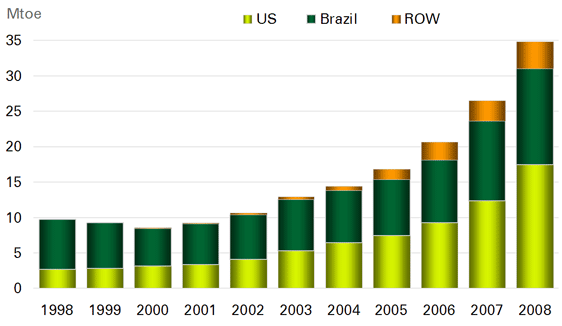Team:UNICAMP-Brazil/Yeastguard/Why
From 2009.igem.org
| Line 1: | Line 1: | ||
{{:Team:UNICAMP-Brazil/inc_topo}} | {{:Team:UNICAMP-Brazil/inc_topo}} | ||
| - | + | __NOTOC__ | |
=The Yeastguard: Motivation= | =The Yeastguard: Motivation= | ||
<p style=”text-align:justify;”>Fuel ethanol is currently made by large-scale yeast fermentation of sugars that are extracted or prepared from crops followed by separation of the ethanol by distillation (1). The two major ethanol producers in the world are US (produced from maize) and Brazil (produced from sugar cane) (1).</p> | <p style=”text-align:justify;”>Fuel ethanol is currently made by large-scale yeast fermentation of sugars that are extracted or prepared from crops followed by separation of the ethanol by distillation (1). The two major ethanol producers in the world are US (produced from maize) and Brazil (produced from sugar cane) (1).</p> | ||
| Line 29: | Line 29: | ||
<p style=”text-align:justify;”>Bacterial contamination is an ongoing problem for commercial fuel ethanol production facilities due to the fact that bacteria compete with the ethanol-producing yeast for sugar substrates and micronutrients (8). Contaminants create a constant drain on carbon available for conversion to ethanol and compete for growth factors needed by yeast. They also produce byproducts that are inhibitory to yeast, particularly lactic and acetic acids (8).</p> | <p style=”text-align:justify;”>Bacterial contamination is an ongoing problem for commercial fuel ethanol production facilities due to the fact that bacteria compete with the ethanol-producing yeast for sugar substrates and micronutrients (8). Contaminants create a constant drain on carbon available for conversion to ethanol and compete for growth factors needed by yeast. They also produce byproducts that are inhibitory to yeast, particularly lactic and acetic acids (8).</p> | ||
<p style=”text-align:justify;”>It is generally believed that lactic acid bacteria are the primary bacterial contaminants of fuel ethanol fermentations, since lactic acid levels often rise during bouts of contamination (8). Lactobacillus sp. And Bacillus sp. may be the most harmful of the bacteria that contaminate molasses because of their rapid growth abilities. Because Lactobacillus sp. are tolerant to high temperature and low pH, it is especially difficult to prevent Lactobacillus sp. from growing (9). The presence of this contaminants causes big losses to the producers.</p> | <p style=”text-align:justify;”>It is generally believed that lactic acid bacteria are the primary bacterial contaminants of fuel ethanol fermentations, since lactic acid levels often rise during bouts of contamination (8). Lactobacillus sp. And Bacillus sp. may be the most harmful of the bacteria that contaminate molasses because of their rapid growth abilities. Because Lactobacillus sp. are tolerant to high temperature and low pH, it is especially difficult to prevent Lactobacillus sp. from growing (9). The presence of this contaminants causes big losses to the producers.</p> | ||
| + | |||
==How can Lactobacillus contamination be controlled?== | ==How can Lactobacillus contamination be controlled?== | ||
<p style=”text-align:justify;”>It has been reported that various agents, including antiseptics such as sulfite, hydrogen peroxide, 3, 4, 4-trichlorocarbanilide, and urea hydrogen peroxide and antibiotics such as penicillin, tetracycline, monensin, and virginiamycin are effective in preventing bacterial contamination. Penicillin and virginiamycin are currently used commercially to prevent contamination in the bioethanol production process, and some facilities use these antibiotics prophylactically (9). Bacillus sp. and Lactobacillus sp. isolated from Brazilian industrial fermentation unitswere shown to be susceptible to penicillin and the ionophore antibiotic monensin (8). However, it is particularly important to prevent bacterial contaminants during bioethanol production without using antibiotics, because all the selective pressure that the use os antibiotics can cause. Moreover, the use of these compounds increases the costs of the production. This way, the idea of our project remains on a possible control for contaminants without the addition of any extra compound on the fermentation vat.</p> | <p style=”text-align:justify;”>It has been reported that various agents, including antiseptics such as sulfite, hydrogen peroxide, 3, 4, 4-trichlorocarbanilide, and urea hydrogen peroxide and antibiotics such as penicillin, tetracycline, monensin, and virginiamycin are effective in preventing bacterial contamination. Penicillin and virginiamycin are currently used commercially to prevent contamination in the bioethanol production process, and some facilities use these antibiotics prophylactically (9). Bacillus sp. and Lactobacillus sp. isolated from Brazilian industrial fermentation unitswere shown to be susceptible to penicillin and the ionophore antibiotic monensin (8). However, it is particularly important to prevent bacterial contaminants during bioethanol production without using antibiotics, because all the selective pressure that the use os antibiotics can cause. Moreover, the use of these compounds increases the costs of the production. This way, the idea of our project remains on a possible control for contaminants without the addition of any extra compound on the fermentation vat.</p> | ||
| + | |||
==Our Project: How to control Lactobacillus contamination on fermentation vats?== | ==Our Project: How to control Lactobacillus contamination on fermentation vats?== | ||
<p style=”text-align:justify;”>Based on the problems caused by lactobacilli contamination on fermentation vats, we developed and idea to try to solve it. We decided to engineer strains of S. cerevisiae and make them able to sense the presence of contaminants and destroy them. This yeasts are going to work as “yeastguards” of the vats, allowing the fermentation to occur without lactobacilli contamination. The elimination of this kind of contamination would decrease the losses in production, which would be extremely helpful to our country economy.</p> | <p style=”text-align:justify;”>Based on the problems caused by lactobacilli contamination on fermentation vats, we developed and idea to try to solve it. We decided to engineer strains of S. cerevisiae and make them able to sense the presence of contaminants and destroy them. This yeasts are going to work as “yeastguards” of the vats, allowing the fermentation to occur without lactobacilli contamination. The elimination of this kind of contamination would decrease the losses in production, which would be extremely helpful to our country economy.</p> | ||
| + | |||
==Yeastgurad: The model== | ==Yeastgurad: The model== | ||
Revision as of 18:24, 21 October 2009
| ||||||||||||||||||||||||||||||||||
 "
"















